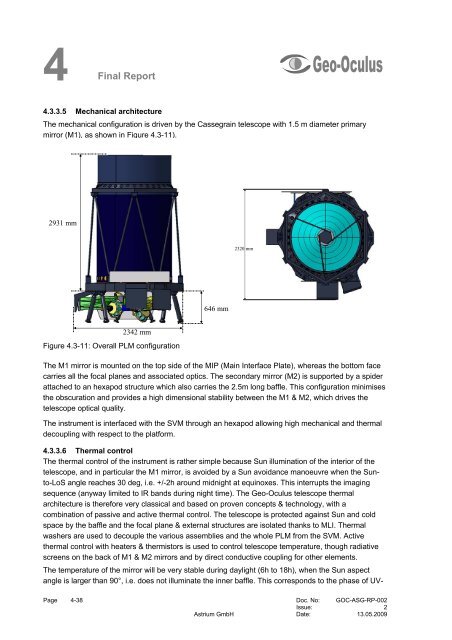4 Final Report - Emits - ESA
4 Final Report - Emits - ESA
4 Final Report - Emits - ESA
Create successful ePaper yourself
Turn your PDF publications into a flip-book with our unique Google optimized e-Paper software.
4 <strong>Final</strong><br />
<strong>Report</strong><br />
4.3.3.5 Mechanical architecture<br />
The mechanical configuration is driven by the Cassegrain telescope with 1.5 m diameter primary<br />
mirror (M1), as shown in Figure 4.3-11).<br />
2931 mm<br />
GEO-<br />
OCUL<br />
US-1<br />
2342 mm<br />
Figure 4.3-11: Overall PLM configuration<br />
646 mm<br />
2320 mm<br />
GEO-OCULUS-3<br />
The M1 mirror is mounted on the top side of the MIP (Main Interface Plate), whereas the bottom face<br />
carries all the focal planes and associated optics. The secondary mirror (M2) is supported by a spider<br />
attached to an hexapod structure which also carries the 2.5m long baffle. This configuration minimises<br />
the obscuration and provides a high dimensional stability between the M1 & M2, which drives the<br />
telescope optical quality.<br />
The instrument is interfaced with the SVM through an hexapod allowing high mechanical and thermal<br />
decoupling with respect to the platform.<br />
4.3.3.6 Thermal control<br />
The thermal control of the instrument is rather simple because Sun illumination of the interior of the<br />
telescope, and in particular the M1 mirror, is avoided by a Sun avoidance manoeuvre when the Sunto-LoS<br />
angle reaches 30 deg, i.e. +/-2h around midnight at equinoxes. This interrupts the imaging<br />
sequence (anyway limited to IR bands during night time). The Geo-Oculus telescope thermal<br />
architecture is therefore very classical and based on proven concepts & technology, with a<br />
combination of passive and active thermal control. The telescope is protected against Sun and cold<br />
space by the baffle and the focal plane & external structures are isolated thanks to MLI. Thermal<br />
washers are used to decouple the various assemblies and the whole PLM from the SVM. Active<br />
thermal control with heaters & thermistors is used to control telescope temperature, though radiative<br />
screens on the back of M1 & M2 mirrors and by direct conductive coupling for other elements.<br />
The temperature of the mirror will be very stable during daylight (6h to 18h), when the Sun aspect<br />
angle is larger than 90°, i.e. does not illuminate the inner baffle. This corresponds to the phase of UV-<br />
Page 4-38 Doc. No: GOC-ASG-RP-002<br />
Issue: 2<br />
Astrium GmbH Date: 13.05.2009

















